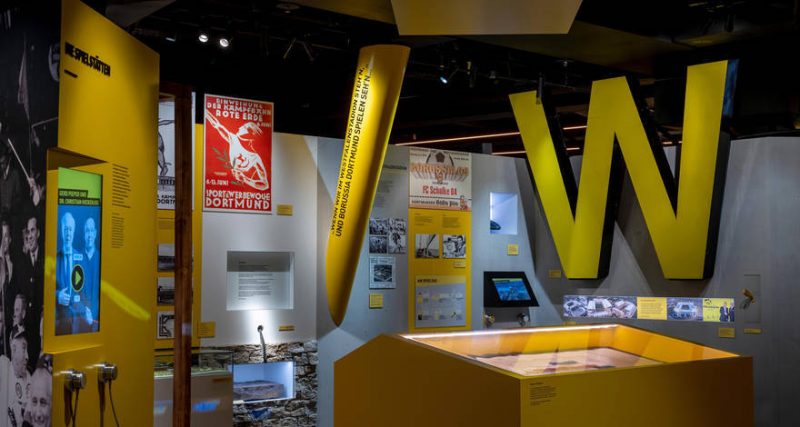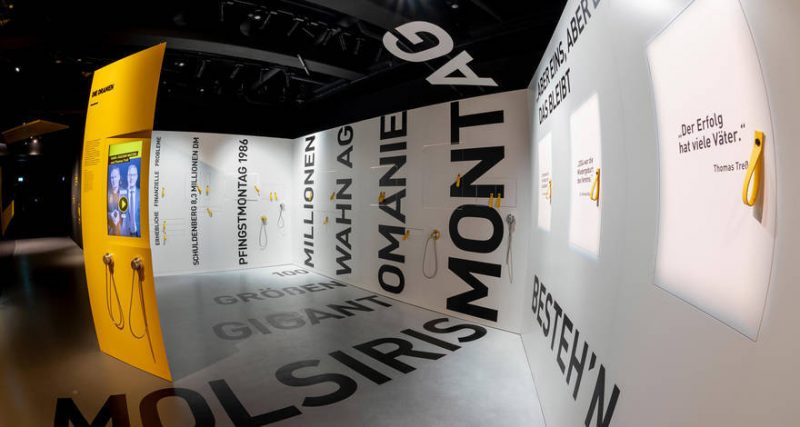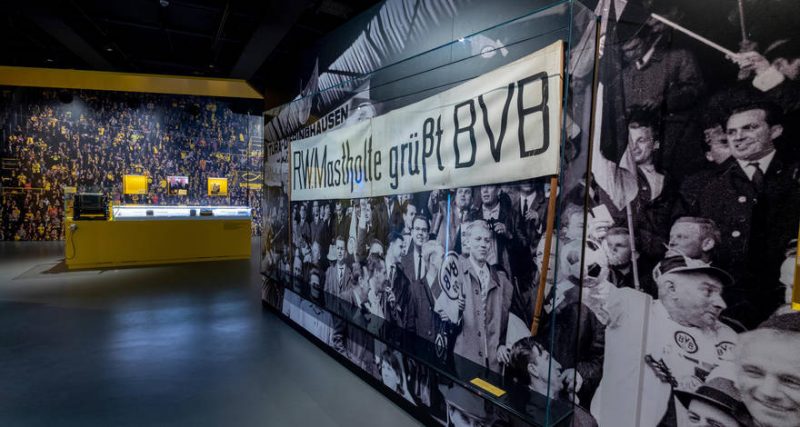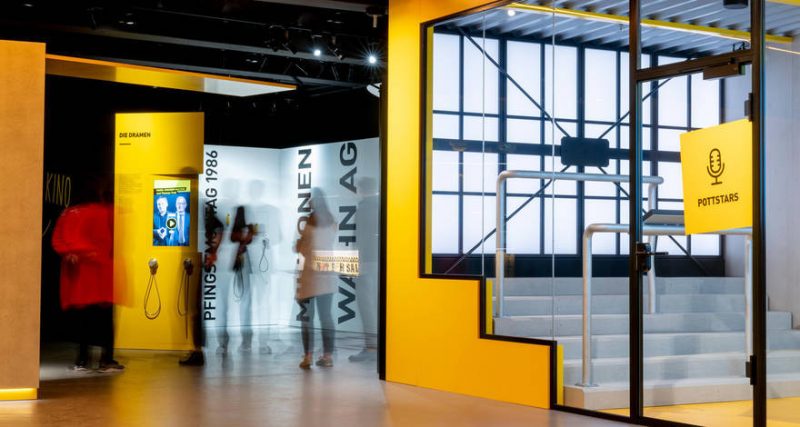Discover Black and Yellow history up close again in the BORUSSEUM 2.0. The new BORUSSEUM is unrecognisable after a complete renovation.
Discover Black and Yellow history up close again in the BORUSSEUM 2.0. The new BORUSSEUM is unrecognisable after a complete renovation. Take a look for yourself!
It’s been a very long road. A long journey. It’s taken two and a half years to renovate the BORUSSEUM. Along the way, it might have felt like you were going round in circles — like driving around Borsigplatz over and over again! But finally it was finished, BVB Museum 2.0. It was opened on 2 April before the home game against Leipzig. Drinks, finger food, speeches, a flurry of camera flashes, bright eyes and satisfied smiles (hidden under FFP2 masks). It was a re-opening that felt more like a new opening because the renovated BORUSSEUM is unrecognisable. This is not to disrespect the “old” museum, it is to celebrate the “new”. We don’t want to give too much away — you should see it for yourselves. But we have to tell you this much: It really is very … very … Borussian!
Reinhold Lunow had been looking forward to 2 April. This was not just any date. On 2 April 1974, the Westfalenstadion was opened — with a match between the women of TBV Mengede and VfB Waltrop and a friendly derby between the then second division team Borussia Dortmund and FC Schalke 04. Exactly 48 years later, Reinhold Lunow had the honour of re-opening the new BORUSSEUM to the public in his function as Vice President and Museum Project Manager. Having negotiated many hurdles with his team in the months leading up to the re-opening, he seemed very happy on the big day. Though he did have one wish: “I really hope that people will come here in large numbers and with pleasure. That they feel welcome and relaxed. I hope that the new BORUSSEUM will become a real home for our huge BVB family. Not just a place of memories and discoveries, but also a hub of active club life, a centre of social responsibility.”
Welcome to the founding history
Reinhold Lunow’s wish is sure to come true because anyone with the slightest bit of black and yellow blood in their veins or adrenaline in their body will love the new BORUSSEUM. BVB fans will experience countless Yes! and Wow! and Remember That? moments. They should bring plenty of time with them because they’ll need it. The exhibition concept will grab them from the moment they turn right at reception and head for the historic Borsigplatz. Welcome to the year 1909. Welcome to the turbulent history of BVB’s founding.
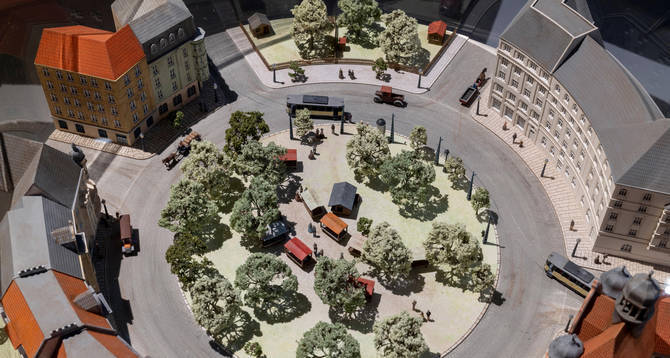
Unlike the old museum, the new BORUSSEUM is not organised chronologically. Instead there are eight zones (why not 09 actually?). There is the founding history, the venues, the national and international competitions, the fans, the timeline, the dramas and the trophy room. The room showcasing the cups and trophies Borussia Dortmund has won in its 113-year history is at the end of the tour. It’s not necessarily hidden away, but it’s also not centre stage, not in the glaring spotlight. The trophy room is no more or less important than the other areas. And that says a lot about the new BORUSSEUM.
Emotions and a down-to-earth attitude
Above all, it shows that Julian Oppmann and Clemens Gatzmaga have captured the essence of Borussia Dortmund and understood how the club operates. Ambition, yes. But this club is about more than titles and triumphs. More than anything it’s about emotions. And a down-to-earth attitude. Oppmann and Gatzmaga, the two founders of the Machen agency, are the creative minds behind the exhibition. They have produced a modern, interactive concept. They make full use of digital media, combining spectacular exhibits with superb audio-visuals to create an unforgettable experience. The museum seems much larger, more open and more spacious than the original BORUSSEUM, although no additional space has been added. Above all, they have created a concept that never goes over the top. There’s no bling, no glitz, no fancy nonsense. “It’s supposed to feel like Borussia Dortmund,” they say. It does feel like Borussia Dortmund.
What stands out is the attention to detail, though it is used so subtly that it’s not immediately noticeable. It waits to be discovered. You will follow the colour guide (the “yellow line”) without even thinking about it and absorb the quotations from club songs and fan chants reproduced on the ceiling and walls. And don’t forget the year numbers on the exhibition walls, whose typefaces match the ones used for the shirt numbers on the respective jerseys. Every zone, every display case and every exhibit is precisely illuminated. Nothing — but nothing — has been left to chance by Machen, the two museum directors Sarah Hartwich and Melanie Wanczura, and the project team.
See, hear, open, scroll
The result is a journey through 113 years of club history. “There’s an incredible amount to discover,” promise Sarah Hartwich and Melanie Wanczura. There’s a lot to see and hear at around 30 digital stations, plenty to open and scroll through on touchscreens. Yellow strap handles stick out of the walls, inviting you to pull out drawers and reveal hidden gems. In the centre of the new BORUSSEUM, visitors are treated to an audio-visual spectacle on an oversized multimedia wall comprising multiple single monitors. “When I saw the films and videos, I had tears in my eyes,” says Reinhold Lunow.
Of course, the museum also has a “proper” cinema. Of course, fans can film themselves standing behind a soundproof glass wall at a crush barrier on a stylised terrace, cheering on their team on the pitch below. And, of course, the BORUSSEUM gives fan culture the attention it deserves in the “Fans” zone. Alongside waistcoats and kitsch, cellar bar vibes and curiosities (such as the BVB rubber duck that made it into space strapped to a balloon), you’ll also find a few cult objects: folded up in an unmarked plastic bag lies the infamous “A lifetime without a trophy” banner that fans had flown over the Veltins Arena on the last day of the Bundesliga season in 2006/07. FC Schalke 04 had failed to become German champions again after a 2-0 defeat in Dortmund the week before.
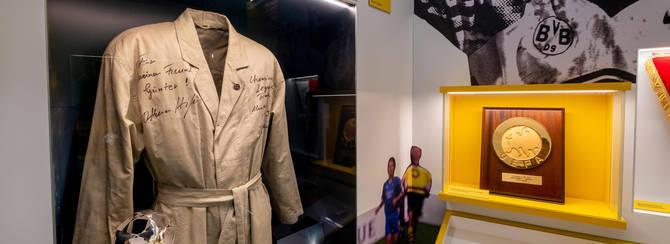
Favourite exhibits of Sarah Hartwich and Melanie Wanczura include the historic beer bottle from the Borussia Brewery as well as another banner: the well-known cloth banner seen in many old black-and-white photos, which members of the East Westphalian amateur club RW Mastholte unrolled to welcome BVB to Hampden Park in Glasgow for the European Cup Winners Cup Final against Liverpool in 1966. The fan who originally made it turned up with the banner at a “legends evening” at SIGNAL IDUNA PARK a few years ago and subsequently made it available to the BORUSSEUM. It now has a place of honour there.
The original pennant from 1963
The same is true of the pennant from BVB’s legendary 5-0 triumph over Benfica in the 1963 European Cup, which was already on display in the old museum — but to a certain extent “bunched together” with other less significant exhibits. “It was only when looking through old photos while working on the new exhibition that we realised it was not simply a fan souvenir but the original match pennant that Borussia’s captain Wolfgang Paul received before kick-off,” explain Julian Oppmann and Clemens Gatzmaga.
And what is Reinhold Lunow’s museum highlight? “I have two favourites,” says Borussia’s Vice President. “Firstly, many people know I am a huge Manni Burgsmüller fan. I had the great honour of giving the eulogy at his funeral. I promised his daughters that their father would get the place he deserved place in the BORUSSEUM. The fact that we now have one of Manni’s jerseys in the exhibition is just fantastic.”
And then Lunow also reveals a very special relationship with the “Dramas” zone, which is by no means about sporting failures, but rather about the economic struggle for survival. In particular the existence-threatening crisis of the 2004/05 season. “I guess it’s unusual for a club to deal self-critically with such times in its own museum,” explains Lunow. But critical periods are as much a part of Borussia Dortmund as championships and cup victories. “I see this room as a kind of memorial,” says the BVB Vice President. “I hope that it will once again remind fans and visitors how close BVB came to insolvency back then and that nothing of what we have experienced since then should be taken for granted.”
Text: Frank Fligge
Photos: Alexandre Simoes
